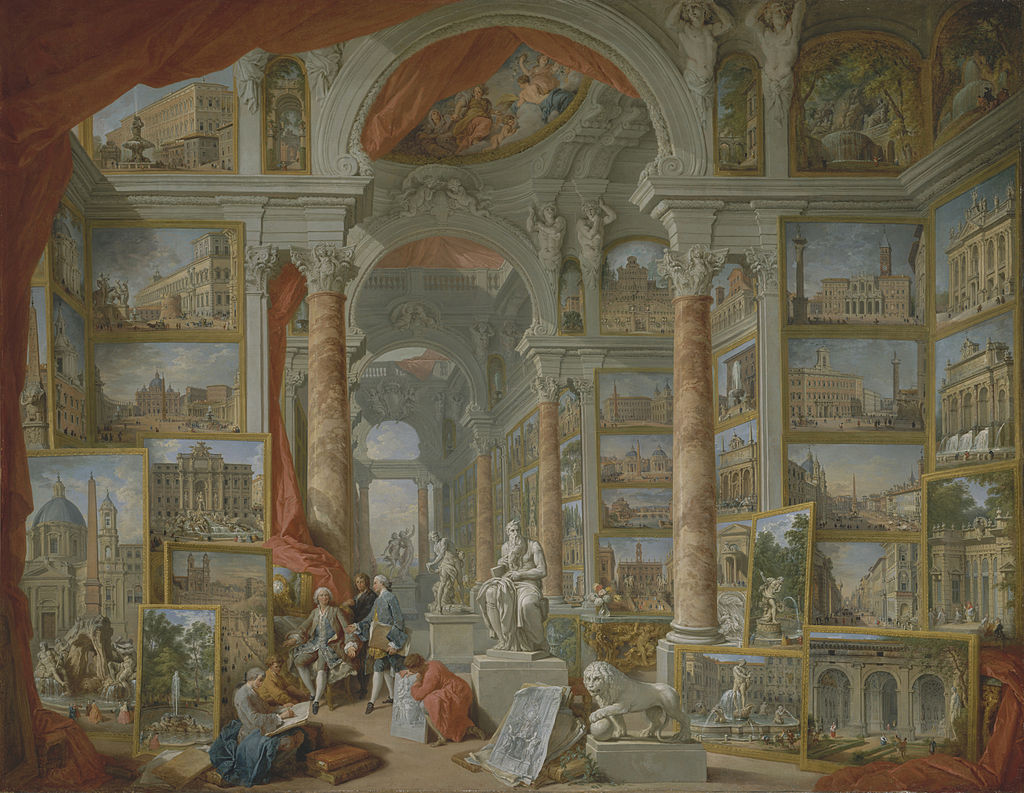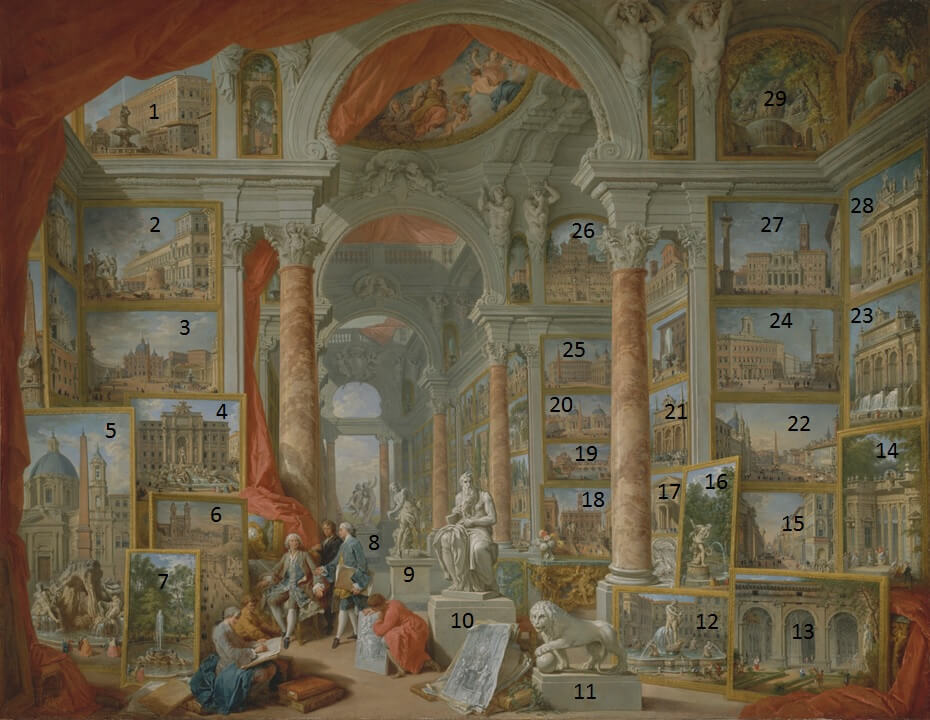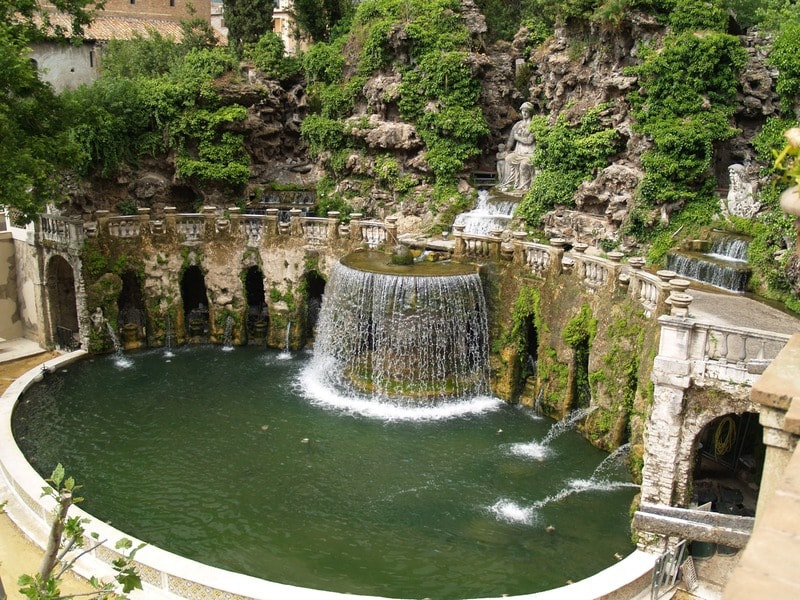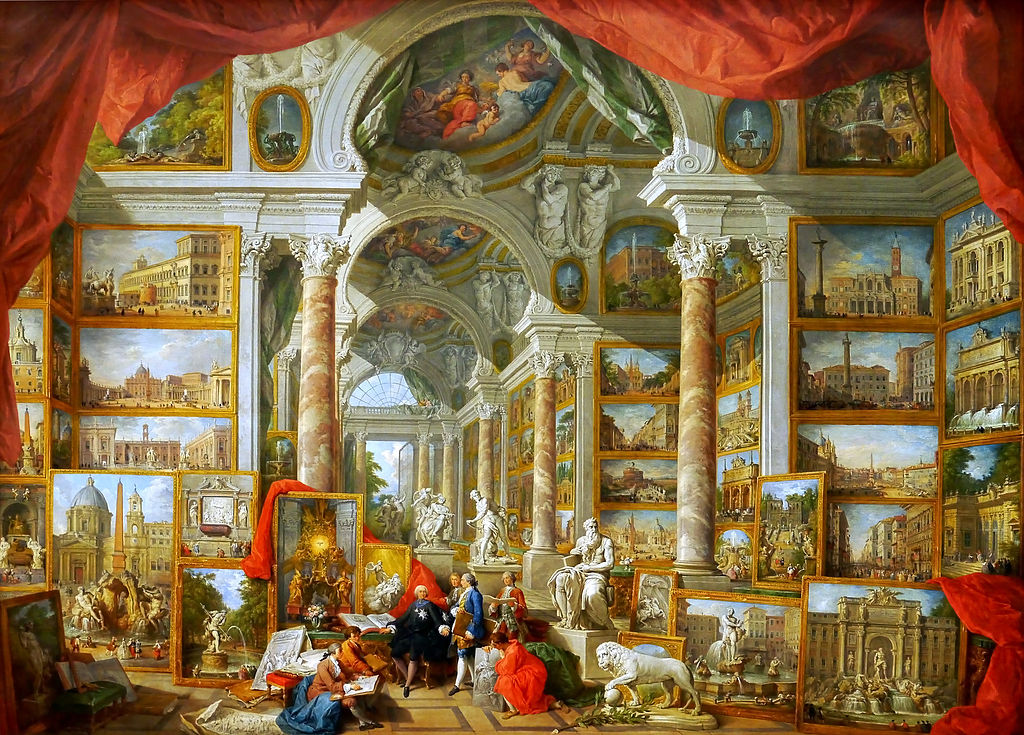|
Where? Room 629 of the Metropolitan Museum of Art and Gallery 246 of the Museum of Fine Arts
When? 1757 Commissioned by? Count de Stainville What do you see? A large number of paintings of buildings, fountains, and monuments in Rome around 1757. The commissioner of this painting, Count de Stainville, who was the French ambassador to the Vatican in Rome between 1753 and 1757, is sitting in an armchair in the foreground. In the painting below the paintings and sculptures are numbered to make it easy to understand what they represent.
Backstory: Panini created a total of three versions of this painting. He created two similar versions for Count the Stainville. The original version is at the Museum of Fine Arts in Boston, and a copy of that version is at the Metropolitan Museum of Art. Two years later, he created a somewhat different version of this painting for Claude-François de Montboissier de Canillac de Beaufort. This version is now in the Louvre in Paris.
The Modern Rome painting in the Metropolitan Museum of Art hangs next to another work of Panini, Ancient Rome, which shows monuments and art from ancient Rome.
What is a veduta? Panini is known for painting views of Rome. These views are called veduta (plural vedute), which is a type of painting that accurately provides a view of a city or another vista. This style initiated in Belgium and The Netherlands in the 17th century and became more popular in 18th-century Italy.
There are two main types of vedute. First, the vedute prese da i luoghi, which are exact representations of a city view or other vista. Second, vedute ideate, which are scenes that also contain some imaginary elements such as buildings or monuments from the past. The current painting by Panini is a good example of the first type of veduta, while his Ancient Rome is a good example of the latter type. As photography did not exist yet, vedute were a great way for rich travelers to bring home their memories. The magnificent vedute by Panini were in high demand in the 18th century, and it is not surprising that painters sometimes created multiple versions of the same veduta painting. Who is Panini? Giovanni Paolo Panini was born in 1691 in Piacenza, Italy, and died in Rome in 1765. He was both an architect and painter and was considered to be the most influential painter in Rome during the 18th century. Early in his career, he mainly painted frescos for the rich people in Rome. From around 1729, he started to focus on painting various views of Rome for which he is best known today. Another example of a veduta painting by Panini is the Interior of the Pantheon of which one version is in the National Gallery of Art, and another version is in the Cleveland Museum of Art. Panini also painted some religious works, but these works have never reached the same amount of fame as his vedute.
Fun fact: At the end of the 16th century, rich people in Europe send their kids on tour through Europe as part of their education. These trips are referred to as Grand Tours. On these trips, kids of about 21 years old typically visited cities such as Paris, Florence, Rome, and Venice. A knowledgeable family member or a professional tutor accompanied them on their tour. For example, the great economist and one of the founders of capitalism, Adam Smith, worked for quite some years as a tutor.
Before the existence of photography, these tours were popular among the rich people in England, Germany, Scandinavia, and the United States. Veduta paintings, such as the ones by Panini, became popular among these people to preserve their memories.
Written by Eelco Kappe
2 Comments
Leave a Reply. |
Categories
All
|
- Home
- Blog
-
Museums
- Alte Pinakothek
- Art Institute of Chicago
- Baltimore Museum of Art
- Barber Institute of Fine Arts
- Bargello
- Barnes Foundation
- British Museum
- Church of Sant’Anastasia
- Cleveland Museum of Art
- Courtauld Institute of Art
- Detroit Institute of Arts
- Frans Hals Museum
- Galleria Borghese
- Gallerie dell'Accademia
- Getty Museum
- Guggenheim
- Hermitage Museum
- Kunsthistorisches Museum
- Kunstmuseum Basel
- Legion of Honor Museum
- Louvre
- Mauritshuis
- Metropolitan Museum of Art
- Musee d’Orsay
- Museum of Fine Arts in Boston
- Museum of Modern Art
- National Gallery in London
- National Gallery of Art
- National Museum in Poznań
- Norton Simon Museum
- Ny Carlsberg Glyptotek
- Palace of Versailles
- Palazzo Pitti
- Palazzo Vecchio
- Petit Palais
- Philadelphia Museum of Art
- Prado
- Pushkin Museum
- Ravenna Art Museum
- Rijksmuseum
- San Diego Museum of Art
- Santa Maria delle Grazie
- St. Peter's Basilica
- Städel Museum
- Statens Museum for Kunst
- Tate Britain
- Tate Modern
- Timken Museum of Art
- Uffizi
- Vatican Museums
- Wallace Collection
-
Artists
- Altdorfer
- Anguissola
- Berlin Painter
- Bosch
- Botticelli
- Boucher
- Bronzino
- Bruegel the Elder
- Brunelleschi
- Cabanel
- Caillebotte
- Canova
- Caravaggio
- Carpeaux
- Cezanne
- Cimabue
- David
- Degas
- Delacroix
- De Maria
- Donatello
- El Greco
- Fontana
- Fra Angelico
- Fragonard
- Gauguin
- Gentileschi
- Gericault
- Gonzalez-Torres
- Goya
- Hals
- Hogarth
- Hokusai
- Ingres
- Leonardo da Vinci
- Lippi, Filippo
- Longhi, Barbara
- Lorrain
- Makovsky
- Manet
- Massys
- Matisse
- Merian
- Michelangelo
- Mochi
- Modigliani
- Monet
- Panini
- Parmigianino
- Perugino
- Picasso
- Pisanello
- Raphael
- Rembrandt
- Renoir
- Reynolds
- Rivera
- Rodin
- Rubens
- Scultori
- Seurat
- Steen
- Tintoretto
- Titian
- Toulouse-Lautrec
- Turner
- Uccello
- Van der Weyden
- Van Dyck
- Van Eyck
- Van Gogh
- Van Hemessen
- Vasari
- Velazquez
- Vermeer
- Veronese
- Vigée Le Brun
-
Locations
- Books
- About Us







